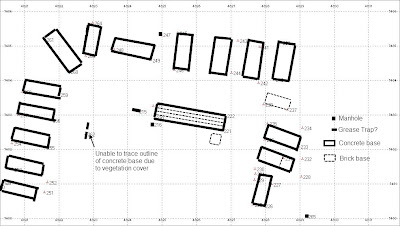Spent two very enjoyable half days at Westleton. On Sunday, met up with David Sims to record a crawl trench system I have already mapped. However this time we mapped it with the traditional method of tape (using a 50 mtr tape) and offsets. This was a learning exercise for me. Mapping this way produces a more accurate plan than the way I usually map with a GPS. However it is very time consuming - it took two of us 4 hrs to map the system as opposed to just under an hour I sepnt using a GPS sometime last year.
On Mon spent a half day mapping another crawl trench system just using the GPS this time. I compared two methods of recoding by GPS:
(1) by marking changes in direction of the trench with way points then 'joining up the dots'.
(2) by recording the trench using a track.
Of the two methods I find using way points to be the most accurate. However if way points are too close together odd results can arise so it pays to make a rough sketch as well to help in producing the plan.
So any conclusions? Recording by tape and offsets is the most accurate and picks up all the twists and turns in a trench system. Using a GPS and 'joining up the dots' (way points) can make the trench system appear much more linear than it is in reality. However it's a very fast way of recoding and does provide an accurate enough record for my purpose.
The system mapped on Monday would again have been for training purposes, presumably dates from 1943 onwards.
Image 1: David Sims recording with 50 mtr tape and offsets
Image 2: Map of the crawl trench system recorded on Monday - both 'joining the dots' with way points and using a track are shown.
Image 3: Crawl trench leading into a weapons-slit
Image 4: Weapons-slit within the crawl trench system
Image 5: Crawl trench
Image 6: Two of quite a few circular pits which may be shell holes from live firing exercises
Image 7: 303 bullet embedded in wood - find quite a few of these!!






